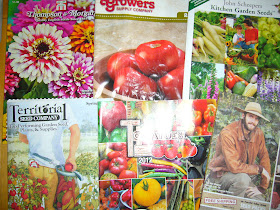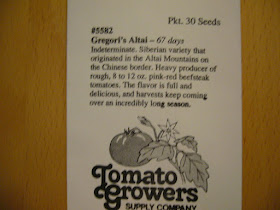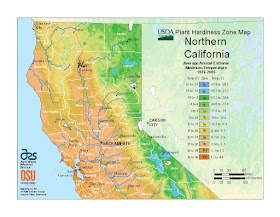 |
| Heirloom Tomato Starter Plants Under Shop Lights |
Into the first turn they go -- the 2012 Race to the Garden Finish is on! It may be bloody cold outside. It might be raining buckets. But inside? Seeds for the 2012 Bird Back 40 summer garden are jumping out of azalea starter cups and dreaming of those long, warm, summer days.
Well -- I might be dreaming. As for the tomato, pepper, eggplant, basil and lavender (yes, lavender! Talk to the boss that is the Wife that is Venus!) -- starters -- well -- as you can tell by the photo to your immediate right? We're off to a fairly nice start here in February 2012.
We are using an entirely new design for our seed starting efforts this year. A design that I'd love to tell you that I came up with. But that would be a big, fat, enormous lie, now wouldn't it? I don't come up with really good gardening ideas folks -- I watch what others do and steal good ideas. In this case? I stole one great idea from a gardener who, unfortunately, is not doing much gardening this year.
 |
| New Seed Starting Rack! |
But she still gets credit for her sheer gardening brilliance.
We have eighty plants in 4.5 inch azalea stater cups this year. That's about 50 tomato plants -- 20 peppers and ten assorted cups of basil, eggplants and lavender (Yes! Lavender! Talk to Venus!). If I were still relying upon the old method of using a PVC contraption on a simple card table to hold up 4-foot long shop lights -- I'd have starter plants stacked on starter plants.
But this is a new year -- and a new idea! Check that -- it's a new year and a stolen idea.
A young East Sacramento lady by the name of Sara S. (last names have been changed to protect the innocent) first tipped me to this rather brilliant idea. Actually -- I had always longed to build my own seed starting rack. There are a million and one do-it-yourself construction plans online to build a seed shelving system. But those required time -- something I have precious little of these days.
 |
| Starter Rack by Target |
It didn't even cross my mind to actually purchase already-made shelving units -- until I came across the setup put together by Sara. She contacted me out of the blue last year -- with an offer of extra starter plants for our yearly distribution efforts at the California State Capitol. It was an offer I gladly accepted.
It's always nice to meet other gardeners who share the same passion and drive that you do. Young or old -- they have new ideas and new techniques to share. You can learn a lot about gardening simply by watching and learning from others. And although Sara is probably young enough to be my daughter -- she trumped my seed starting designs and efforts by an East Sacramento mile.
The rack that you see pictured above was recently purchased from Target at nominal cost. It's almost as if the designers had gardeners in mind. It is the perfect fit for holding two four-foot long shop lights on each row. The rack has five rows. Each row can hold up to 40 azalea cups and starter plants. If you do the math -- you'll come to discover that I could be growing far more starter plants than I am this year.
 |
| Pepper Starters Under Shop Light |
Hey, man, I didn't want to push it! 80 is more than enough.
I am also using a somewhat different technique for starting seeds this year. I call it the "tough love" treatment. I am no longer providing my starters with as much love and warmth as possible. As a matter of fact, although the plants are inside, in a spare room, I am exposing them daily to a jolt of the rather cold conditions outside. I am also going without bottom heat this year.
Why the tough love treatment? In past years, I had always done my best to provide a warm and welcoming environment for plants. That meant a room closed off completely to the outside elements. It meant bottom heat for the starter cups. It meant a fan to simulate an outdoor breeze.
 |
| Cracked Window Allows for Cold Air Circulation |
Do you know what this loving atmosphere resulted in? Lots of plants, yes. But they were plants with very weak stems. They would invariably require stakes to hold them aloft -- plus a good two to three weeks outside to harden off and gain stem strength.
There has to be a better way.
So -- this year? The bottom heat is gone. The nice warm room -- history. Cold, drafty, outdoor conditions have been introduced. Who knows? I might even wind up dumping the shop lights. The goal isn't to produce plants with long stems that can snap in two during a spring breeze. My goal, by introducing a little bit of that rough world outside, is a strong root system.
 |
| Seed Starting Rack Assembled by Gardening Moron |
If I have a starter plant that is firmly rooted, with an extensive and healthy root system to boot, by the time April rolls around? Strong stem development will almost certainly follow as I begin to expose the plants to the outdoor elements.
So far -- the experiment is working. Germination was a bit slower this year. But -- two weeks after planting -- I'm pleased to report 100%, across-the-board germination with every tomato, pepper, eggplant, basil and lavender (Yes, LAVENDER! Talk to the Wife that is Venus!) in those 80 starter cups. The tomatoes have already developed their first set of true leaves.
What are the advantages to this system? The biggest advantage that I can think of, at this point, is we won't be doing any transplant work later this spring. The cups are large enough to hold tall, healthy starter plants. By the time these starters actually become root bound -- the hope is they will be ready to transplant into a permanent, raised bed home.
Bill Bird still dreams of a true greenhouse in the backyard. A greenhouse that offers the prospect of year-round tomato and cucumber production. But this do-it-yourself backyard landscaping experiment with all things fruit trees and raised beds for gardening production is taking a bit longer than I thought it would. I'm closer to the greenhouse prize than I was four years ago when a barren, backyard moonscape greeted us upon our move to the Bird Back 40.
As a wise gardening friend once preached: Patience. Our time will come.

























.jpg)

